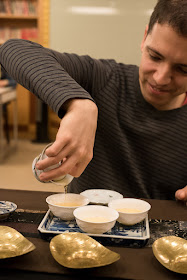During today's tea class, we brewed the same winter 2017 top Hung Shui Oolong from Dong Ding with 3 vessels: a porcelain gaiwan, an Yixing zisha Shipiao and my old Yixing Duanni Tiliang teapot. We started with the porcelain gaiwan in order to experience the taste and aromas of this tea with a neutral material (glazed porcelain).
It's early March and still cool in Taiwan. This season is a good fit for using Yixing teapots to brew tea, because they stay warm longer than porcelain. So, even if I recommend to use porcelain to better compare different teas, now is still a good time to understand how Yixing teapots improve roasted Oolong.
My student Antonio brews the same tea with this zisha Shipiao teapot. The tasting experience is very different from the gaiwan. The first impressions are more muted, more refined. At first, the tea seems smoother and almost weaker, but then the aftertaste builds and builds and builds. Now, the tea feels stronger because it lasts so much longer! The aromas are also a little different. They are not as direct, but seem filtered as if they had been turned into essential oil!
In parallel, I'm brewing the same tea with my old duanni Tiliang teapot. (It has a similar shape and size as the zisha Shipiao). It performs very similarly in terms of aftertaste, but the smoothing effect goes beyond what the zisha does and the aromas seem to retain a little bit more freshness.
By going back to another brew with the gaiwan, it's obvious that the gaiwan produces lighter fragrances and much less aftertaste because the thin porcelain looses heat much faster than Yixing clay. This loss of flavor wouldn't be such loss with a fresh, lightly fragrant green tea or a high mountain Oolong. However, for a Hung Shui Oolong, the Yixing clay helps emphasize the long aftertaste which is the core character of this tea.
With the right Yixing teapot, we found gold brewing this roasted Oolong!







No comments:
Post a Comment